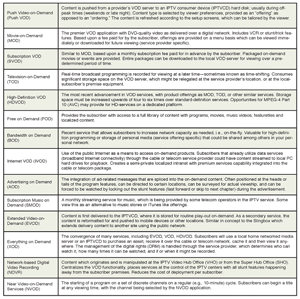VOD in Demand

Emerging from the depths of pay TV, video-on-demand and its widespread acceptance by the consumer has forever changed the way we view television programming. Pay-per-view—the supplying of one-time events, specials and premium motion pictures—was inaugurated in 1974 by the cable industry with the first live implementation being in Columbus, Ohio. At first, ordering a PPV-service involved a dial-up order and selecting a timeslot. You would wait for that slot, then you'd tune in to a dedicated encrypted channel and watch. The charge for the event was added to your monthly bill.
Later, a dedicated PPV application, sometimes viewed as the "dawn of interactive TV," would be installed on a set-top box or downloaded from the network and stored into local memory. The menu driven selection activity was then accessed by a subscriber, an order was placed and depending upon availability, would be immediately available, or if it was a one-time only special event, it was watched in real time on the specific channel it was authorized on. The ability to store a program locally on the set-top box came later, and in some cases may be prohibited (i.e., blocked) because of rights issues.
Although the basics of PPV remain the same, competition from new services means that much of the TV viewing experience now has some form of digital video recorder and VOD incorporated extending the quality of experience even further. This evolution of PPV, VOD, the home DVR and interactive television has now grown from its simple roots to become a near household word.
(click thumbnail)Most young television viewers probably have no concept of looking at the TV Guide to select a program. Audiences no longer need to plan their activities around a television schedule, as the shows can be seen on the DVR, stored to a network computer, downloaded to a portable media device or streamed direct to their laptop. They can even remotely watch a cable service on any Internet accessible solutions with additional equipment placed in the home adjacent to the set-top box.
There will soon be no argument that VOD, and its close cousin the DVR, will replace the VCR for routine television viewing. And for those with a next-generation view into modern media technologies, the home media network may certainly be well on its way to becoming the next ancillary element in the food chain sitting right next to the DVR and VOD.
A PPV only service—where no DVR is involved—might be based upon a computing model (known as a "push to" model), whereby content is broadcast at scheduled intervals and you just tune in when you want. For most viewers, this model, which grew from the direct-to-home satellite, is not nearly as popular because it requires that viewing the content remain governed around someone else's schedule. The cable companies dramatically altered this model (in the late 1990s) with the first generation of server based PPV services. The telecoms have taken the experience to another level with IPTV.
The last few years has seen an enormous growth in the VOD sector, driven in part by improvements in smaller, cheaper and faster VOD-servers; and by deployment of the next generation network infrastructures. The former being promoted by manufacturers of servers, and the later by the inclusion of real time two-way interactive communications for all.
IP-VOD
VOD is classified as a "pull to" model. The delivery workflow starts when a library of content is prepared by a major content delivery provider (e.g., HBO, Starz, etc.) per specifications agreed upon by the receiving organization (e.g., for cable—Comcast or Time Warner, and for IPTV—Verizon or AT&T). That compliant content is then sent to the cable or telco-IPTV company for storage on their VOD servers located in their cable headends. Depending upon the requirements of each organization, the content may already be compiled and structured for play-out, or it may again be transformed to suit the local cable or IPTV service's specific formats and data structures.
For a successful IP-based video-on-demand (IP-VOD) service to function with some or all of the features for on-demand viewing (see sidebar for descriptions of the service offerings), a high capacity two-way broadband network is required. The technical implementation consists of physical and logical blocks which consist of IP-VOD streaming servers, transport protocols and interactive IP-VOD client applications.
The streaming servers required for these services are typically located in the IPTV data center. It is at this location where encoding, multiplexing and the modulation of the content for delivery onto the network are performed. High-capacity servers are configured to meet the requirements and the demands for delivering content to customer located IPTV consumer devices. Advanced storage systems act as the central repository for the entire content library, as such, these storage architectures must be scalable in both physical capacity and in bandwidth. The IP-VOD server devices are not unlike what broadcasters might use to collect programming from content originators prior to formatting and transferring them to their local broadcast play-out servers (i.e., a digital delivery service such as Pathfire)—except their scale and bandwidth is significantly greater overall.
QUALITY CONTROL
Content may be delivered as baseband video over satellite or as videotape, although the later model is dwindling in popularity. When baseband video content is the medium (e.g., videotape), the starting point for the IP-VOD streaming workflow is to QC the content, then encode the content using MPEG-2, H.264 (AVC) or VC-1 (Windows Media) and then store it to the IP-VOD storage platform. Alternatively, pre-encoded content provided by a program origination service is nearly always delivered over satellite, where it is then transferred direct into the IP-VOD servers' storage platform.
The server platform may be a commercially provided device from a major vendor or it may be constructed by the IP service provider. The IP-VOD streaming servers are nearly always assembled using high performance, fast I/O, but with otherwise conventional off-the-shelf components. Some facilities may employ a hybrid set of storage solutions consisting of both spinning mechanical hard disk drives in a RAID (Redundant Array of Independent Disks) configuration and solid-state memory disks.
Processors in the servers must be high powered, often requiring multithreaded operations that can handle the activity in a system of this scale. Activities including concurrent access for incoming content and a huge volume of outgoing video streams necessitate customized applications that manage the throughput for the delivery platforms. Substantial buffering and caching space is required for VOD content as well as a large database to index the title information, the destination IP-stream addressing and the continual diagnostics necessary to manage the overall VOD architecture. Scaling of service capabilities often requires orders of magnitude increases in server streaming capacity as well as storage.
OPTIONS
For the broadcaster interested in looking into VOD capabilities for their news or public services, or for original content programming, at least two options are available. The first is to employ their own Internet-based streaming network for delivery to home PCs or to mobile cellular networks. The second is to engage the local cable or IPTV service provider(s) who may already have employed the IP-VOD or other baseband VOD server platforms, which could be updated to include content provided by the broadcaster. The latter, while new and more limited in availability, requires the least amount of capital expenditure for the broadcaster. The Internet streaming or cached network, which could be more like a near-VOD system with an Internet modeled delivery platform, may be simpler to establish, especially if the broadcaster already is served by a secondary hosting service at a group level.
Once a VOD delivery platform is established, the opportunities to extend that media forward into mobile/handheld terrestrial over-the-air devices (ATSC-M/H) are not far off. Once the rollout of DTV is complete, and M/H is established, NVOD for television broadcast may be just a few pieces of hardware and software away.
For these public, broadcast or private services the implementation of any scale of VOD service is only as good as the connectivity and the ability for the services to grow. A variety of application providers are currently able to set up and configure VOD services, and those entities are expected to multiply quickly over time.
Karl Paulsen is chief technology officer for AZCAR Technologies. Karl is a SMPTE Fellow and an SBE Life Certified Professional Broadcast Engineer. Contact him at karl.paulsen@azcar.com.

Get the TV Tech Newsletter
The professional video industry's #1 source for news, trends and product and tech information. Sign up below.

Karl Paulsen recently retired as a CTO and has regularly contributed to TV Tech on topics related to media, networking, workflow, cloud and systemization for the media and entertainment industry. He is a SMPTE Fellow with more than 50 years of engineering and managerial experience in commercial TV and radio broadcasting. For over 25 years he has written on featured topics in TV Tech magazine—penning the magazine’s “Storage and Media Technologies” and “Cloudspotter’s Journal” columns.
